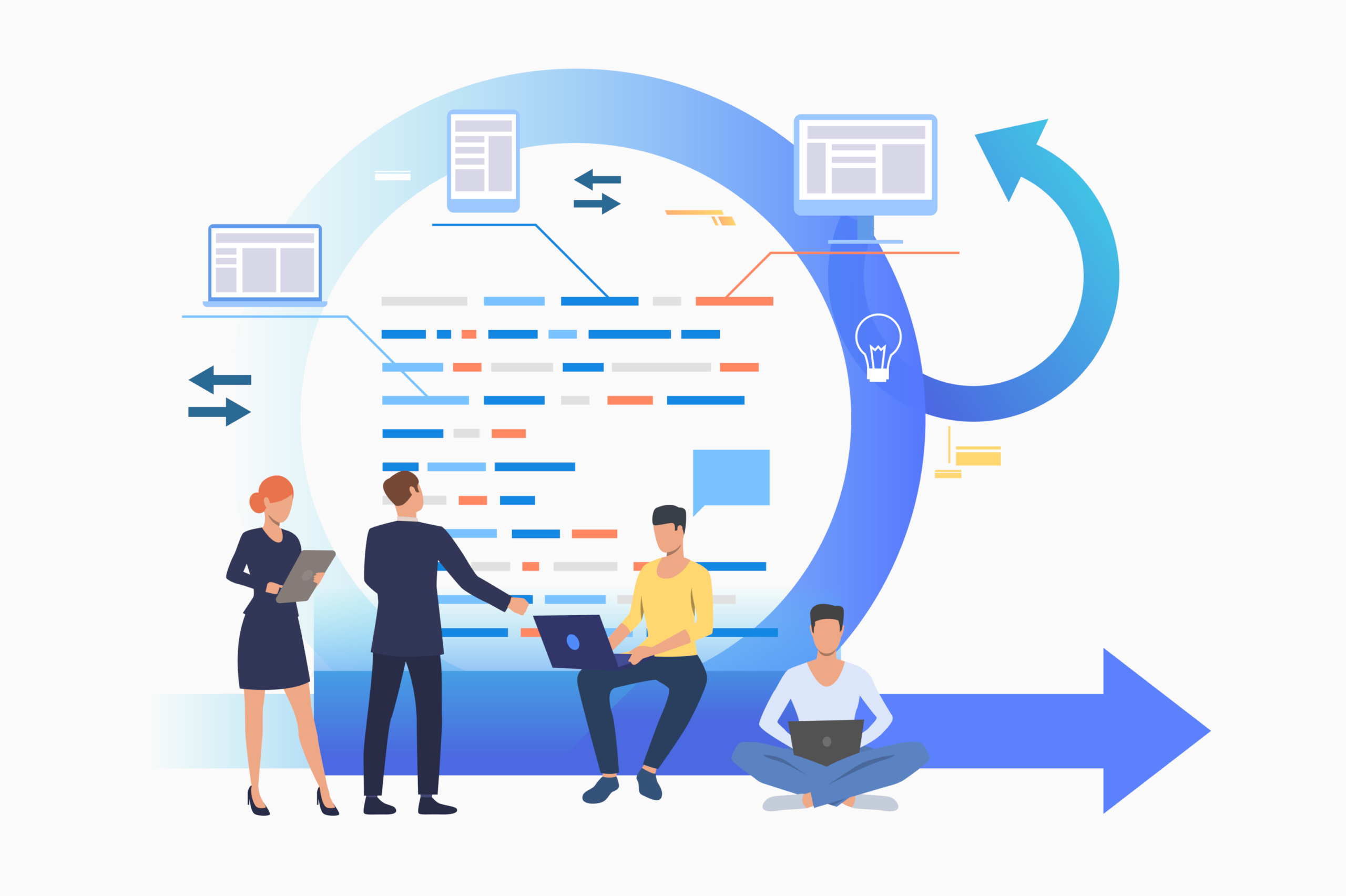In today’s fast-paced world of technology, the term “Agile Product Owner” has become increasingly significant. Agile methodologies have gained prominence in organizations due to their ability to enhance productivity and maintain high-quality outputs.
In this blog, we will delve into the essential responsibilities and skills of an Agile Product Owner, exploring their role in technology organizations and how they contribute to successful software development projects.

What is an Agile Product?
In general terms, an agile product refers to a software development approach, in which flexibility, collaboration, and iterative progress are of greater emphasis. In this approach, we can see the breaking down of projects into smaller tasks assigned to every agile team member. Agile teams work on the said tasks and are expected to deliver incremental value to customer and stakeholder needs.
Regular feedback and customer involvement ensure that the product meets their needs and evolves based on changing requirements. Agile’s focus on adaptability and customer-driven development has made it a popular methodology in the software industry.
What is Product Development Cycle?
The product development cycle, often referred to as the process of product development, is a step-by-step approach used by organizations to bring a new product from the concept to the market. It involves careful planning, design, development, testing, and eventual launch of the product.
Although the specific stages may vary depending on the industry, company, and complexity of the product, the typical cycle of product development includes the following steps:

Idea Generation: During this initial stage, various ideas for new products or enhancements to existing ones are brainstormed and explored. Ideas may arise from customer feedback, market research, internal innovation teams, or other sources.
Idea Screening: In this phase, the generated ideas undergo evaluation and screening to determine their feasibility, alignment with company goals, technical viability, and market demand. Not all ideas proceed beyond this stage.
Concept Development: Viable ideas are further developed into concrete product concepts. These concepts outline the product’s key features, target audience, value proposition, and potential business impact.
Feasibility Study: A detailed feasibility study is conducted to assess the technical, financial, and operational aspects of the product concept. This study helps determine whether the product can be developed within given constraints and if it is financially viable.
Product Planning: During this stage, a comprehensive product plan is created, encompassing the product’s specifications, design, development timeline, resource allocation, and marketing strategy.
Design and Development: The actual design and development of the product take place in this phase. Prototypes, mock-ups, and alpha versions of the product are created, and iterative development and testing occur to refine the product’s design and functionality.
Testing and Quality Assurance: The product undergoes thorough testing and quality assurance to identify and rectify any defects or issues. This stage ensures that the product meets the required quality standards and user expectations.
Product Launch: Once the product is fully developed and tested, it is launched into the market. This involves marketing and promotional activities, setting up distribution channels, and ensuring adequate customer support.
Post-Launch Evaluation: After the product is launched, its performance is closely monitored. Customer feedback is collected to assess the product’s reception, identify areas for improvement, and plan potential updates.
Product Maintenance and Updates: Products require ongoing maintenance, bug fixes, and updates to stay relevant and competitive in the market. Continuous improvements and updates are made based on customer feedback and changing market trends.
Who Is a Product Owner?
A Product Owner is a key role in Agile and Scrum methodologies within software development and product management teams. The Product Owner acts as the bridge between stakeholders and the development team, representing the interests of customers, users, and the business. Every product owner is responsible for defining and prioritizing the product backlog, which is a list of features, enhancements, and tasks that need to be completed during the development process.

The Product Owner collaborates with stakeholders to gather requirements, validate assumptions, and ensure that the product meets customer needs and aligns with business goals. A product owner also works closely with the development team to provide clarifications, make decisions, and guide the development process to deliver valuable products incrementally. Overall, the Product Owner plays a crucial role in maximizing the product’s value and ensuring successful product development.
Responsibilities of an Agile Product Owner
In the realm of software development, an Agile Product Owner shoulders critical responsibilities that significantly impact project success. Here are the key duties of an Agile Product Owner:

Crafting the Product Vision
At the core of their role, the Agile Product Owner defines a compelling product vision. This involves deep comprehension of market demands, customer requirements, and business objectives to provide clear direction to the development team.
Overseeing the Product Backlog
The Product Owner takes charge of managing the product backlog, which is a prioritized list of tasks, features, and user stories. They actively collaborate with stakeholders and the development team to adapt and refine the product backlog as necessary.
Prioritizing with Precision
Ensuring efficient value delivery, the Product Owner prioritizes tasks in the product backlog. Their goal is to align priorities with the product vision and overall business goals, focusing on delivering high-impact features first.
Seamless Communication
A proficient communicator, the Agile Product Owner acts as the primary liaison between the development team and stakeholders. They keep all parties well-informed by sharing the product vision, backlog priorities, progress, and any roadblocks.
Fine-Tuning User Stories
Collaboratively with stakeholders and the development team, the Product Owner creates well-defined user stories that represent specific functionalities from an end-user perspective.
Establishing Acceptance Criteria
For each user story, the Product Owner sets precise acceptance criteria to ensure clarity on task completion conditions, fostering a shared understanding among the team.

Consistent Stakeholder Engagement
Engaging stakeholders consistently throughout the process, the Product Owner gathers feedback, validates assumptions, and incorporates inputs to refine and optimize the product.
Embracing Change
Agile Product Owners gracefully adapt to changing requirements and market dynamics. Flexibility in adjusting priorities and refining the product backlog based on new insights is a hallmark of their approach.
Value Maximization
With accountability for product value, the Product Owner makes informed decisions to optimize development efforts, balancing customer needs and project constraints to deliver high-value outcomes.
Team Collaboration
Working closely with the development team, the Product Owner ensures seamless communication, clarifies requirements, and offers context to achieve the envisioned product.
Incremental Delivery
Agile Product Owners advocate for incremental product development, fostering continuous feedback loops and early value delivery to customers.
Validating Product Increment
Before a product increment is released, the Product Owner verifies its alignment with acceptance criteria and the product vision, ensuring the delivered functionality meets expectations.
Agile Product Owner vs. Scrum Product Owner
In the realm of software development methodologies, the roles of Agile Product Owner and Scrum Product Owner share some similarities but also possess distinct characteristics. Let’s delve into the key differences between Agile Product Owner and Scrum Product Owner:

Agile Product Owner
In the realm of software development approaches, Agile encompasses a diverse range of methodologies, and one prominent among them is Scrum.
The role and responsibilities of an Agile Product Owner extend beyond those of other roles within the Agile framework. Their primary focus revolves around defining the overarching product vision and goals. By engaging with stakeholders and the development team, they ensure a seamless alignment with business objectives and customer requirements.
Notably, Agile Product Owners possess the versatility to adapt their role effectively to various development methodologies, extending beyond the boundaries of Scrum.
Scrum Product Owner
Specifically designed within the Agile methodology, Scrum establishes a well-defined structure consisting of roles, events, and artifacts.
Within the Scrum framework, the Scrum Product Owner shoulders the responsibility of managing the product backlog. This involves meticulous prioritization of tasks and providing essential guidance to the development team throughout each sprint. Their ultimate aim lies in ensuring the delivery of work items within sprints with utmost precision.
Unlike Agile Product Owners, who can navigate various development approaches, Scrum Product Owners operate exclusively within the confines of the Scrum framework. They adhere steadfastly to its unique practices and principles to drive the project’s success.

Shared Responsibilities
While there are notable distinctions between Agile and Scrum Product Owners, they do share certain responsibilities:
Both roles involve fostering effective communication between stakeholders and the development team to ensure smooth collaboration.
Both Product Owners work towards maximizing the value of the product and delivering high-quality solutions that meet customer needs.
Complementary Roles
Agile and Scrum Product Owners complement each other in the software development process:
An agile product owner sets the big picture and long-term vision for the product, guiding the overall direction.
Scrum Product Owners focus on short-term goals and priorities within sprints, ensuring the team works on the most valuable tasks.
The Synergy between Product Roadmap and Scrum Team
The product roadmap is a strategic planning tool that outlines the product’s vision and development goals. It provides a high-level view of key milestones and feature releases. The Scrum team, comprising developers, a Scrum Master, and a Product Owner, works in iterations called sprints to deliver increments of the product.
The product roadmap guides the team’s efforts by providing long-term direction and aligning with the business strategy. During sprint planning, the Product Owner selects work items from the product backlog based on the roadmap’s priorities. The Scrum team’s incremental development approach ensures continuous progress toward the product’s vision.
Regular sprint reviews validate the product increment against the roadmap’s objectives, allowing for adaptations if necessary. By integrating the product roadmap with the Scrum team’s development process, organizations ensure a focused and value-driven approach to product development.
Key Skills for Agile Product Owners
Agile Product Owners demand a wide array of essential skills to adeptly navigate the ever-changing and collaborative landscape of software development. These proficiencies empower them to steer projects toward success while delivering products of substantial value. Below are the pivotal skills that every Agile Product Owner should possess:

Communication
Effective communication stands as a foundational skill for an Agile Product Owner. The ability to articulate the product vision, backlog items, and progress with precision is paramount when engaging with development teams and stakeholders. Seamless collaboration with Scrum members and stakeholders ensures timely updates and smooth team functionality.
Technical Details
An Agile Product Owner’s prowess lies in a comprehensive grasp of technical aspects encompassing project management, development, design, software engineering, and the Scrum methodology. Proficiency in understanding user interface design and product development architecture proves invaluable in estimating timelines and prioritizing user stories effectively.
Critical Thinking
Informed decision-making serves as a linchpin in an Agile Product Owner’s role. Skillfully prioritizing tasks and making discerning choices that shape the product’s outcome are central responsibilities. Identifying potential hurdles, analyzing alternative approaches, and selecting the most suitable options to maximize product development efforts all fall within their purview.
Collaboration
The crux of an Agile Product Owner’s success lies in their collaborative spirit. Close collaboration with the software development team is indispensable in building a triumphant product. This entails specifying user features, assigning deadlines, and diligently evaluating the engineering team’s output against customer requirements.
Analytics
To optimize the product development, analytical prowess is a must for an Agile Product Owner. Adroitly gathering and utilizing information to solve complex problems proves critical. Evaluating multiple issues and skillfully determining optimal solutions, such as adjusting the product backlog based on the software team’s capacity, are just some examples of their analytical prowess.
Key Takeaways for Agile Product Owner
Agile Product Owner plays a critical role in software development projects, ensuring the successful delivery of valuable products. Here are the key takeaways for Agile Product Owner:

The Pivotal Role of the Agile Product Owner
Within the product development process, the Agile Product Owner assumes a pivotal role. As the conduit between stakeholders and the development team, they bear the responsibility of ensuring the product aligns seamlessly with stakeholders’ expectations and requirements.
Unceasing Learning and Skill Enhancement
To thrive in the capacity of an Agile Product Owner, continuous learning and skill enhancement are imperatives. Remaining up-to-date with the latest methodologies and industry trends equips the Agile Product Owner to adeptly adapt to the ever-evolving project dynamics.
Optimizing Product Value
Through adept ownership of agile products and fostering close collaboration with stakeholders and development teams, Agile Product Owners wield the power to maximize the product’s value and its impact in the market. Their expert guidance and strategic decisions propel the product’s success to new heights.
Conclusion
In conclusion, Agile Product Owners play a pivotal role in technology organizations, ensuring successful software development projects. They are responsible for understanding product goals, managing the product backlog, ensuring transparency and collaboration, and employing key skills like effective communication and critical thinking.
Continuous learning and skill growth are essential to excel in this role and maximize the value of the product. By embracing the principles of Agile methodologies and effective product ownership, Agile Product Owners can lead their teams to success in today’s dynamic market.
FAQs
What are product owner responsibilities in agile?
Product Owner responsibilities in Agile involve taking on a pivotal role as the bridge between stakeholders and the development team. They are tasked with defining and communicating a clear product vision and outlining the project’s objectives and goals. Additionally, Product Owners are responsible for managing the product backlog, a dynamic to-do list that outlines all tasks and features required for project completion.
By regularly grooming the product backlog, they ensure tasks are prioritized based on urgency, importance, and other logistical considerations, optimizing the development process. Transparency is another core responsibility, as Product Owners must keep stakeholders informed about progress, challenges, and changes. Effective communication with the development team and stakeholders is vital for seamless collaboration and project success.
What skills are required for agile Product Owner?
To excel as an Agile Product Owner, a range of skills is required. Effective communication is fundamental, as they need to convey the product vision, backlog items, and progress to stakeholders and the development team. Technical knowledge, encompassing project management, development, design, software engineering, and familiarity with the Scrum methodology, is vital. Critical thinking is crucial for prioritizing tasks and making informed decisions.
Collaboration skills are necessary for working closely with the development team, specifying user features, and ensuring alignment with customer requirements. Lastly, strong analytical abilities are essential for gathering and using information to optimize the development process and adjust the product backlog based on the team’s capacity.



